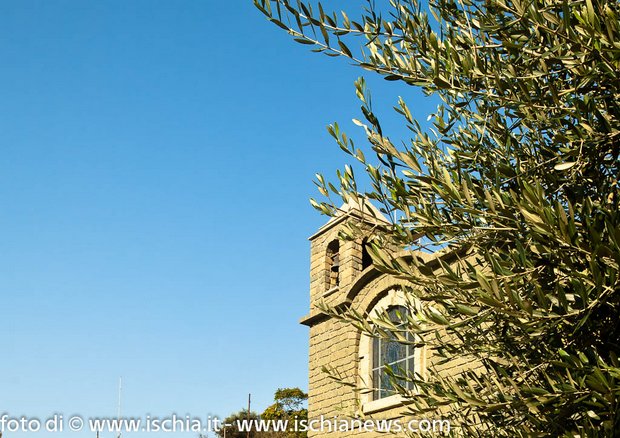San Ciro: St Ciro: the Green Church on clear waters
 "“After leaving the village of Panza ... you go to meet the Ciglio farmhouse overlooking valleys, hills and other houses which still form part of the parish of Serrara. It is called Ciglio (Eyelash) because the ancient mythologists islanders and foreign poets considered it a place where the giant Typhoeus, buried under the island, shaped his lashes while a campaign just below called ‘the mouth and the belly’, corresponding to the head of this giant, was Testaccio and feet Pieio or piede.
"“After leaving the village of Panza ... you go to meet the Ciglio farmhouse overlooking valleys, hills and other houses which still form part of the parish of Serrara. It is called Ciglio (Eyelash) because the ancient mythologists islanders and foreign poets considered it a place where the giant Typhoeus, buried under the island, shaped his lashes while a campaign just below called ‘the mouth and the belly’, corresponding to the head of this giant, was Testaccio and feet Pieio or piede.
Rural and petty house consists of a few scattered houses, rustic dwellings and a chapel dedicated to St. James. A stream of clear water, fresh and restaurant, which descends from Epomeo flows in a small spring at the foot of a hill which is the square before the church ....”. So Giuseppe D’Ascia describes the “House of Ciglio” in his monumental “Storia dell’ isola d’ Ischia” of 1864, the fundamental text about the history, geography and traditions of the island.
The church dedicated to St. James and Assumption was founded in 1661 by Agostino Iacono, but was destroyed by the earthquake of 1883 and probably close to these ruins, in the late nineteenth and early twentieth century, was built with stones of green tuff of Epomeo a new church that was dedicated, in addition to Our Lady of the Assumption, also to martyrs Cyrus, patron of the sick. For the reconstruction of this church played a crucial role a young priest of Serrara, Don Vincenzo Mattera, who died at the age of 38 in 1905 to whom is now dedicated the square in front of the church which acts as a churchyard. Neglected for years by the monumental circuit of the island, thanks to the tenacity of Mrs. Flora D’Andrea, was built 10 years ago the Ixion Association for the restoration of historical monuments and artistic heritage of the island, a rigorous restoration work presented to the islanders and tourists on September 22, 2011 with a moving ceremony during which it was affixed on the steeple the wooden cross, designed by master craftsman Mario Muscariello and was blessed the entrance staircase to the church, by master Gennaro Trani.
“We started with the support of the Emiddio Mele Foundation and the faithful of the parish priest of Serrara, Don Angelo Iacono, of the City of Fontana-Serrara, the Superintendency of Monuments in Naples, a rigorous restoration of the church built entirely with stone feature green tuff of Epomeo and we have just wanted to re-evaluate the art of working the green stone making a real school’s art of stone-cutters in a site like this, Ciglio, which must be preserved, restored, enhanced in its ancient values giving an opportunity for tourism development for the residents and all the islanders and tourists”, says Ms. D’Andrea showing the restored church.
“We also need to properly channel the stream of drinking water that falls from Epomeo and running through the basement of the church because this is a church on the water mentioned in the D’Ascia’s work”, continued Ms. D’Andrea announced that the restoration of the whole site will continue creating an adjoining fund, belonging to the Church, which is a rector of the parish of Serrara, a historical park that highlights the agricultural economy of the island and the art of working the green stone.
The Ciglio church, of extraordinary beauty, was also visited by German Chancellor Angela Merkel during her visit to St. Angelo, and deserves to be included among the most interesting monuments of local history because it highlights in particular the ingenuity of an ancient population that knew so well to work the local stone used in houses, cellars, shelters and places of worship.
by Giuseppe Mazzella































